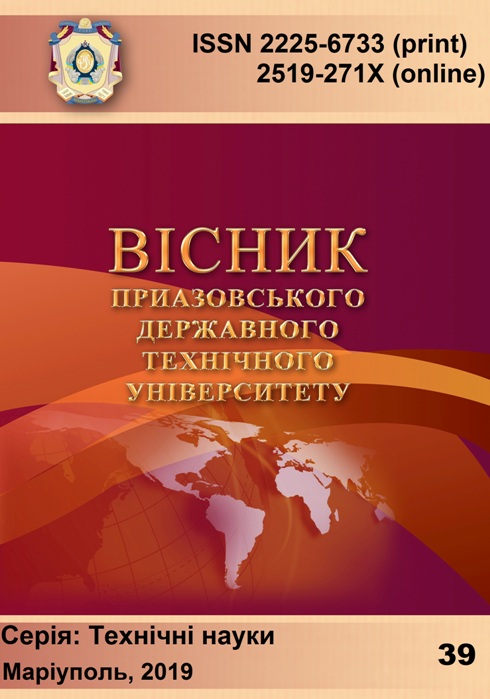Дослідження доцільності розкислення киснево-конвертерного напівпродукту кусковим карбідом кремнію з ціллю поліпшення показників виробництва
DOI:
https://doi.org/10.31498/2225-6733.39.2019.201041Ключові слова:
конвертер, металевий розплав, розкислювання, карбід кремнію, хімічний склад, відмінності середніхАнотація
Раціональне розкислювання металу і шлаку, що включає технологію розкислювання і вибір розкислювачів, є найважливішою операцією сталеплавильного виробництва. Ця акція безпосередньо впливає на кількість неметалічних включень і їх властивості. Вибір типу розкислювача і технології розкислювання кожне металургійне підприємство вирішує по-своєму. Нині широке застосування знайшли різні металеві і неметалічні матеріали, які використовуються для розкислювання металу. До них відносяться традиційні – чушковий і порошкоподібний алюміній, феросплави і ті, що знайшли застосування останнім часом – відходи металургійних виробництв: шлаки алюмінієвого, ванадієвого і абразивного виробництв, карбід кремнію. Нині стало абсолютно очевидним, що використання різних видів і прийомів технології розкислювання і позапічної обробки металевого розплаву дозволяє вирішувати багато проблем в кожному конкретному виробництві. При цьому вирішувати наступні завдання: регулювати кількість і склад неметалічних включень; знижувати собівартість сталі за рахунок оптимізації металургійних акцій стосовно конкретних умов виробництва; забезпечити необхідну якість отримуваної продукції. Тому роботи, спрямовані на подальше вдосконалення прийомів позапічної обробки в кожному конкретному виробництві, являються, безумовно, перспективними і актуальними. Передумовою для вибору прийомів розкислювання і вибір розкислювачів позапічної обробки має бути комплексне дослідження металу на різних етапах металургійної переробки. У наданій роботі представлені результати дослідження процесу виробництва сталі з використанням карбіду кремнію в якості розкислювача при виробництві конвертерної сталі, що виплавляється в конвертерах місткістю 350 т з верхнім продуванням ЧАО «МК «Азовсталь». На основі даних про хімічний склад і температуру металевого розплаву, що отримані в умовах кисневої конвертації, з використанням пакету програм StatSoft Statistica 10.0 виконаний аналіз впливу карбіду кремнію, як розкислювача, на значущість відмінності середніх значень хімічного складу конвертерного розплавуПосилання
Перелік використаних джерел (ДСТУ):
Константинов М.Е. Исследование возможности использования карбида кремния для раскисления и легирования стали / М.Е. Константинов, А.В. Оленченко // Литье и металлургия. – 2004. – № 13 (31). – С. 79-82.
Коровин В.А. Термодинамика восстановления железа из электропечного шлака и изменение теплового баланса в печи / В.А. Коровин, Т.Д. Куриленко, П.П. Степанов // Труды НГТУ им. Р.Е. Алексеев. – 2014. – № 2 (104). – С. 190-195.
Баландин Д.С. Исследование влияния технологии раскисления и легирования стали на степень усвоения легирующих элементов / Д.С. Баландин, С.А. Храпко // Металлургия XXI столетия глазами молодых: тезисы докл. участ. Всеукр. науч.-практ. конф. студ. – Донецк, 2011. – С. 213.
Пат. 2631570 Россия, МПК C 22 B 1/243, C 21 C 7/06. Комплексный раскислитель стали на основе кускового карбида кремния / В.А. Алексеенко. – № 2015148356; заявл. 11.11.2015; опубл. 25.09.2017, Бюл. № 27. – 5 с.
Деревянко И.В. Кинетическая модель взаимодействия карбида кремния с железоуглеродистым расплавом // Металлургическая и горнорудная промышленность. – 2006. – № 3. – С. 30-32.
Тимошенко Я.Г. Особливості структуроутворення композиційної кераміки на основі оксиду алюмінію за участю продуктів відновлення оксиду заліза нанорозмірним нестехіометричним карбідом кремнію / Я.Г. Тимошенко, М.П. Гадзира // Порошкова металургія. – 2015. – № 03/04. – С. 70-77.
Li H. The Application of SiC in Converter Steelmaking / Hailing Li, Qichun Peng, Youhua Wang // Proceedings of the 3rd International Conference on Mechatronics and Information Technology (ICMIT 2016). – 2016. – Pp. 786-790. – Mode of access: DOI: 10.2991/icmit-16.2016.142.
References:
Konstantinov M.E., Olenchenko A.V. Issledovanie vozmozhnosti ispol’zovaniia karbida kremniia dlia raskisleniia i legirovaniia stali [Study of the possibility of using silicon carbide for deoxidation and alloying of steel]. Lit’e i metallurgiia – Foundry production and metallurgy, 2004, no. 13 (31), рр. 79-82. (Rus.)
Korovin V.A., Kurilenko T.D., Stepanov P.P. Termodinamika vosstanovleniia zheleza iz elektropechnogo shlaka i izmenenie teplovogo balansa v pechi [Thermodynamics of iron reduction from electric furnace slag and change in heat balance in the furnace]. Trudy NGTU im. R.E. Alekseev – Transactions of NNSTU n.a. R.Е. Alekseev, 2014, no. 2 (104), рр. 190-195. (Rus.)
Balandin D.S., Hrapko S.A. Issledovanie vliianiia tekhnologii raskisleniia i legirovaniia stali na stepen’ usvoeniia legiruiushchikh elementov. Tezisy dokl. uchast. Vseukr. nauch.-prakt. konf. stud. «Metallurgiia XXI stoletiia glazami molodykh» [Study of the influence of steel deoxidation and alloying technology on the degree of assimilation of alloying elements. Proceedings of the All-Ukr. Sci.-Pract. Stud. Conf. «Metallurgy of the 21st Century through the Eyes of the Young»]. Donetsk, 2011, р. 213. (Rus.)
Alekseenko V.A. Kompleksnyi raskislitel’ stali na osnove kuskovogo karbida kremniia [Complex deoxidizing steel based on lump silicon carbide]. Patent RU, no. 263157, 2017. (Rus.)
Derevyanko I.V. Kineticheskaia model’ vzaimodeistviia karbida kremniia s zhelezouglero-distym rasplavom [Kinetic model of the interaction of silicon carbide with an iron-carbon melt]. Metallurgicheskaia i gornorudnaia promyshlennost’ – Metallurgical and Mining Industry, 2006, no. 3, рр. 30-32. (Rus.)
Timoshenko Ya.G., Gadzira M.P. Osoblivostі strukturoutvorennia kompozitsіinoї keramіki na osnovі oksidu aliumіnіiu za uchastiu produktіv vіdnovlennia oksidu zalіza nanorozmіrnim nestekhіometrichnim karbіdom kremnіiu [The Structurization of Aluminum Oxide Composite Ceramics Involving Products of Iron Oxide Reduction by Nanosized Nonstoichiometric Silicon Carbide]. Poroshkovaia metallurgiia – Powder Metallurgy, 2015, no. 03/04, рр. 70-77. (Ukr.)
Hailing Li, Qichun Peng, Youhua Wang. The Application of SiC in Converter Steelmaking. Proceedings of the 3rd International Conference on Mechatronics and Information Technology (ICMIT 2016), 2016, pp. 786-790. doi: 10.2991/icmit-16.2016.142.
##submission.downloads##
Як цитувати
Номер
Розділ
Ліцензія
Журнал "Вісник Приазовського державного технічного університету. Серія: Технічні науки" видається під ліцензією СС-BY (Ліцензія «Із зазначенням авторства»).
Дана ліцензія дозволяє поширювати, редагувати, поправляти і брати твір за основу для похідних навіть на комерційній основі із зазначенням авторства. Це найзручніша з усіх пропонованих ліцензій. Рекомендується для максимального поширення і використання неліцензійних матеріалів.
Автори, які публікуються в цьому журналі, погоджуються з наступними умовами:
1. Автори залишають за собою право на авторство своєї роботи та передають журналу право першої публікації цієї роботи на умовах ліцензії Creative Commons Attribution License, яка дозволяє іншим особам вільно розповсюджувати опубліковану роботу з обов'язковим посиланням на авторів оригінальної роботи та першу публікацію роботи в цьому журналі.
2. Автори мають право укладати самостійні додаткові угоди, які стосуються неексклюзивного поширення роботи в тому вигляді, в якому вона була опублікована цим журналом (наприклад, розміщувати роботу в електронному сховищі установи або публікувати у складі монографії), за умови збереження посилання на першу публікацію роботи в цьому журналі.









